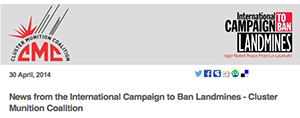29 March 2011
A CCW Protocol on Cluster Munitions: Weaker Protection for Civilians
A draft protocol on cluster munitions (CCW/GGE/2011-II/2), perhaps in reorganised form, is being considered for submission to CCW Parties for possible adoption as a legal instrument “to address urgently the humanitarian impact of cluster munitions…”. The text developed so far is a complicated mixture of loopholes and unverifiable standards. It is both legally and morally incoherent and adoption of this as an instrument would be a regression of international law. Most importantly, it is likely to mean weaker protection for civilians in the future. Should states adopt the draft CCW protocol, then cluster munitions will continue to cause harm to civilians. Adoption would, at least in the eyes of some, re-legitimize a banned class of weapons, and could even result in greater overall usage than in the past.The CCW should drop this proposal, and call an end to negotiations in November at the Review Conference. Five years of unproductive negotiations is enough. Supporters of the Convention on Cluster Munitions should urge all other states to join the Convention, and should encourage those not yet ready to join to implement the strongest national measures that they can.Concern that this draft Protocol might mean weaker protection for civilians in the future can be justified on two bases:
- Firstly, concern that the Protocol will facilitate use of cluster munitions which might otherwise not be used. This would come from the Protocol serving as a shield against the political cost and stigma that derives from these weapons already being subject to a comprehensive prohibition in international law (the 2008 Convention on Cluster Munitions). This might also come from the Protocol being weaker than national standards that certain stockpilers might already have in place – and its adoption being used as a basis for relaxing these national commitments.
- Secondly, by setting a precedent in international law for new instruments that are weaker than established legal protections, this would break with the long-standing tradition of international humanitarian law (IHL) as a progressive effort to protect people from the scourge of war. Such a precedent could be taken up not only for other weapon systems but also for other practices that are considered abhorrent.
- Many aspects of the definitions both of a cluster munition and of a prohibited cluster munition are incapable of being meaningfully tested (e.g. “1% failure rate”, “anti-ship munitions”) – which means each individual State will be able to make different claims about what is or is not allowed. In the case of anti-ship munitions, it would make it impossible to ascertain the legality of a particular weapon until after it has been used.
- The draft Protocol allows cluster munitions with various features that have been shown not to provide adequate civilian protection in practice (e.g. self-destruct mechanisms). The very same solutions that are now contained in the draft Protocol were rejected by the states negotiating the CCM, precisely because they saw that they were unrealistic and impracticable as solutions to the problems that cluster munitions cause,. If the CCW adopts solutions that arguably are both unrealistic and impracticable, it is difficult to see how this is an earnest attempt to address the humanitarian effects of cluster munitions.
- In addition, the Protocol contains extensive transition periods that allow continued use and transfer of weapons that it purports to prohibit. The Protocol would, eventually, stop further use of very old legacy munitions. But the benefit of this is likely to be minimal by comparison with the negative impact of the Protocol asserting that the remainder of cluster munitions (and weapons defined as cluster munitions in the CCM but not under this Protocol) are legal and acceptable. In addition, the proposed Protocol’s impact is further diminished in light of the fact that the aging legacy cluster munitions that would eventually fall under its provisions are of limited military utility and likely to be past the date at which they can be considered for military use or continued storage.
- Proponents of the draft law claim that its measures are better than nothing. However, this fails to recognise that the current proposal actually risks increasing the number of people killed and injured. The civilians and deminers that had to face contamination from M85 cluster munitions in Lebanon in 2006 can testify that such measures are insufficient. By agreeing a law that endorses these measures, at a time when cluster munitions as a whole are being rejected, the likelihood of these weapons being used in the future greatly increases.
- In addition, the central standards in the draft Protocol fall below those already adopted at a national level by at least one major producer, stockpiler and past user - the USA. There is therefore no basis for arguing that the Protocol in its current form will have any humanitarian benefit in relation to the USA’s stockpiles and practices. In fact there may be grounds for concern that this Protocol could be used as a basis for relaxing standards of humanitarian protection adopted at a national level.


